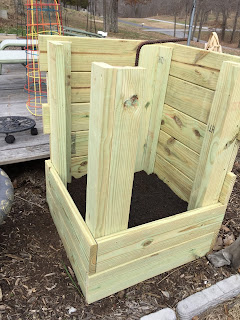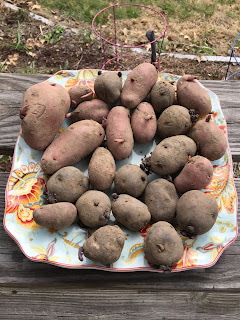My garden consists of four parts: the perennials that come back year after year in the same spots and pots, the self-seeders that pop up in different spots, the stand by annuals I plant every year, and the new varieties I try each year.
In January, I started seeds indoors. I started onion seeds which I transplanted outside in early March. I also started carrot seeds, onion sets and snow peas outdoors in late February and March. The onion seedlings are doing well. Most of the onion sets and snow peas sprouted. The carrots have not yet popped their heads out of the ground, but it shouldn't be long.
In February, I did a second round of indoor seeds and again in March. These seeds were for the summer garden. This week, I finished planting daffodils, Sweet William and marigolds around the perimeter of all my beds.
Perennials
The perennials in my garden are herbs (thyme, tarragon, oregano, garden chives, garlic chives, spearmint, lemon balm, horseradish), the vegetables (Egyptian walking onions, sweet Egyptian walking onions, potato onions, shallots, garlic, asparagus, sorrel, rhubarb, the fruits (strawberries, blackberries, raspberries, Aronia bush, goji berry), and the flowers (daylilies, peonies, hydrangeas, daffodils, hellebore, surprise lilies, gladiolas, coreopsis, hollyhocks).
I started marjoram, Alpine strawberries, different types of creeping thyme and lavender indoors in February. I plan on planting those all the way around all my beds. They deter voles and deer.
The potato onions, raspberries, and blackberries, I planted in the fall. I started a black goji berry bush and another variety of coreopsis from seed last week. I also started some new perennial flowers from seed last week, Platinum Blue flower, Lupine Sunrise, Blue Queen Butterfly pea, Passion flower, Purple Prairie flower, Snow in Summer, Aubrietia Whitewell Gem, Joe Pye Weed, and Alyssum Gold Dust. The flowers are for the new bed we put in the fall.
Self-seeders
There are some self-seeders I can count on and others that are a nice surprise. The ones guaranteed to pop up are zinnias, amaranths (Love Lies Bleeding and Chinese Bicolor), Cocks comb, carrots, celery, chard, Giant Leaf mustard, my purple sprouting broccoli, Hummingbird vine, Morning glory, Red Malabar spinach, and Giant Blue Feather lettuce. I will also get different varieties of other lettuces popping up here and there and usually Chinese Hilton cabbage.
Edibles
I have started all of my edibles except the beans, squash, melons and cucumbers which I will start in small pots outdoors this week. The seed potatoes are cut and hardening. I hope to get them planted this week, too. The Jerusalem artichokes are planted. I am waiting on the sweet potato slips. They don't get planted until it is really warming up in May.
Edible Stand Bys
Pole Beans-Blauhilde purple snap beans, 1500 Year Old snap or shelled beans, Christmas speckles lima beans, Purple or Red Chinese Noodle beans, Urizun Japanese winged beans. All but the winged bean will be in the garden bed.
Okra-Red Burgundy (2)
Tomato plants (10) -Italian Pear paste, Cherokee Purple, Chocolate Pear, Brandywine, an early variety and a fun one or two
Eggplant (3)-AO Daimura, Antigue or Rotanda Bianca or Rosa, Shiromaru or Amadea in pots
Cucumber (2) – bush varieties in garden bed
Summer squash-Trombetta since it is resistant to vine borer and squash bugs.
Winter squash (2) – Butternut from saved seed and a new one
Snow peas in pots with peppers and eggplants
Dragon Tail radish in pot by sprouting broccoli
Hilton Chinese cabbage (2 plants)
Lettuce (Royal Oakleaf, Grand Rapids, Butter King, Bronze Beauty, Giant Blue Feather, Red Sails and a couple new ones) and spinach in pots
Snow peas in pots with peppers and eggplants
Dragon Tail radish in pot by sprouting broccoli
Hilton Chinese cabbage (2 plants)
Greens that stay sweet in summer-Orach, New Zealand spinach in pot
Sweet and hot peppers-variety to make chili powder (3 plants), Jigsaw and Baklouti hot pepper plants, and 4 sweet pepper plants (a chocolate one, banana, bell, and Habanada)
Herbs-Dill, Basil (Nunum, Genovese, Cardinal), Lion's Ear, Rosemary, Parsley, Garden Sage, Chervil, Multicolor Sage, marjoram
Cantaloupe-Tigger melon
Cucumber-bush type
Flowers-zinnias, alyssum, marigolds, Cock's Comb, peach hollyhocks, blue morning glory, Love Lies Bleeding
New Ones
Greens-Tong Ho Big Leaf, Chijimisai, Japanese Mountain Spinach chard, Barese chard, Tronchuda kale.
Onions-Australian Brown, New York Early, Rossa di Milano, and sweet onion sets
Herbs-Lemon savory, Winter savory
Potatoes in the potato boxes - Yukon Gold, ones from saved seeds (yes, some potatoes actually develop seeds from their flowers)
Sweet potatoes-Purple, orange and white variety pack from Southern Exposure
Dwarf Tamarillo-small orange fruits
Pumpkin-Ayote Green Flesh for pies and bread
Melons-Maybe Prescott Fond Blanc, Kajari or Lemon Drop?
No watermelon, beets, heading cabbage or broccoli
Vole repelling plants around the perimeter of all my beds
I will also need to thin my Hummingbird vines, Morning Glory vines, celery, Red Malabar spinach, Giant Blue Feather lettuce and Giant sweet mustard plants out as they come up next year.













